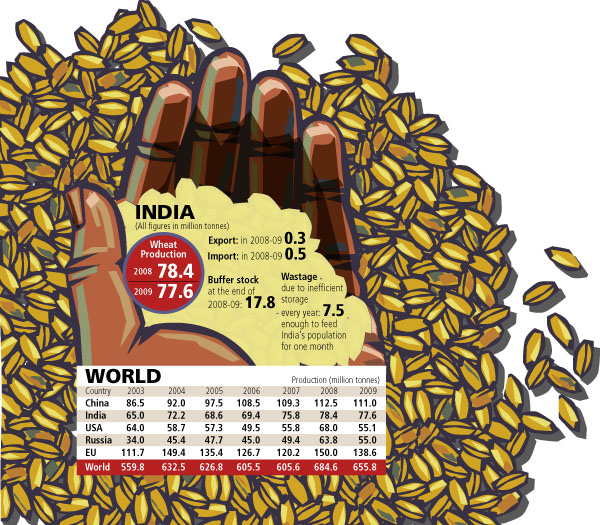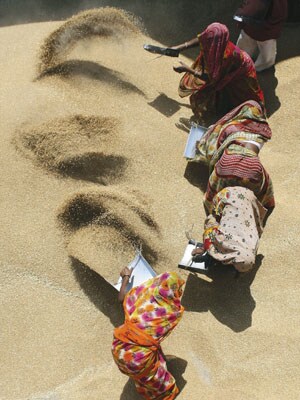
Axis of Wheat
Russia wants to include India in its strategic reserve plan for wheat. India will need to handle its foreign relations and grain storage much better to take advantage of that
In June, 2009, at the World Grain Forum, organised by the Food and Agriculture Organization (FAO) in St. Petersburg, Russia, Viktor Zubkov, the first Deputy Prime Minister of Russia, made an announcement. He stated that he was in consultations with the governments of India, China and Turkey to build wheat reserve stocks in their respective countries, as a move towards providing food security. He also said that he was keen to promote joint ventures with overseas investors to develop the 20 million hectares (2.47 acres to a hectare) of unused arable land available with Russia. This offer was reiterated in September at the FAO summit.
Russia’s wheat production had crossed 63 million tonnes and it was looking to produce 100 million tonnes in 2010. Ramping up production faced two major challenges. One was: How to increase production? Second: How to prevent a collapse in prices thanks to overproduction? The first challenge was not a big one for Russia to surmount — it had the largest reserves of land and water compared to any other country in the world. It could ramp up production easily if it could get the right technology, labour and investments in place.
The second was a bit trickier. The last thing any farmer wanted was a collapse in prices. That is where the largest wheat consuming countries — India, China and Turkey — had to be roped in as partners. If this could be done, Russia could not only become the biggest grain producer in the world, but could also blunt the US’ constant use of the wheat diplomacy card with developing nations (Indians are still upset about the PL-480 deals that the US forced on India in the 1960s and ’70s).
India is at a crossroads now. Should it join hands with Russia or should it partner with the US? “Logically, India should opt for the best deal, without being tied down to any one player,” says a former ministry of external affairs diplomat who prefers anonymity on this issue. Russia is making an offer which the US hasn’t. If the terms are right and the long-term price commitments attractive, India should tie up with both countries thus preventing a situation where India would have to import wheat at astronomical prices.
That India will have to import food grains is evident to everyone. The fields of Punjab — the grain basket of India — are getting less fertile with salinity because of the excessive use of fertiliser and rapid depletion of ground water reserves. Rice that should have been grown extensively in the North-East is instead being grown in Punjab and Haryana. Water scarce Maharashtra grows sugarcane — a water intensive crop.
The case is even more critical in the case of pulses, which provide most Indians their protein component in their food. These pulses are consumed almost nowhere in the world except in India, Pakistan, Bangladesh, Nepal and Sri Lanka. Official estimates expect the country’s pulses production to increase from around 14.86 million tonnes in 2009-10 to around 15.73 million tonnes in 2011-2012 (a 6 percent increase). But, demand for pulses is expected to rise faster from 18.29 million tonnes in 2009-10 to around 19.91 million tonnes in 2011-2012 (9 percent). Increasing population and reduction of poverty are both likely to see demand rise faster than official estimates. Today, India imports pulses from Malaysia, Brazil, Argentina and Indonesia.
Unfortunately, when India or China — large consuming markets — decides to purchase anything from spot markets, prices tend to zoom by 25 to 50 percent. In case both decide to purchase anything — be it oil, oilseed, cement, fertilizers, or food grain — at the same time, prices may shoot up by even 100 percent. That is why long-term contracts and buffer stocks are critical to the country’s food situation.
Sadly, the government does not pay attention to this, says an executive from the Central Warehousing Corporation (CWC), which stores much of the grain that the government procures either from domestic markets or from overseas. In July 2009, a leading publication (India Today) secretly filmed how 300,000 tonnes of pulses that “were imported from the international market using taxpayers’ money … are lying [to rot for several months] at Tuticorin port . . . and in the warehouses of CWC.”
“In fact, there is a general destruction of value in all our food grain and vegetables, at multiple levels, and the government isn’t even bothered about it,” says an industrialist engaged in providing refrigeration services to agro-producers.

Illustration: Malay Karmakar
First there is a destruction of value in perishables not being stored, or being destroyed on the way to the markets. Then comes the procurement process. When support prices are announced for wheat or rice, the procurement is actually done by the state government and stored in state warehouses which are neither temperature- or humidity-controlled, nor protected from insects and rodents. This grain lies with state governments for a few years before being transferred to the central government at a loss because of the destruction (or theft) of the food grain. That is one reason why losses running into thousands of crores of rupees can be seen on the books of almost every state government which procures food grains. The central government too puts this grain in CWC warehouses which are similar to state government warehouses, exposed to rodents, humidity and pests.
That is why, in 2000, the ministry of agriculture and food floated a global tender for scientifically designed silos and warehouses. Adani Logistics Ltd. (ALL) won the global tender to build as a pilot project silo storage units with a total capacity of 600,000 tonnes at seven centres in India. “We think this is critically important if India has to manage its food security, and are waiting for the pilot project to be converted into a bigger full-fledged storage plan,” adds, Pranav Adani, director, ALL.
Alok Sinha, former chairman, Food Corporation of India, is on record stating that “without such storage facilities, India will continue to lose out on the food front”. Whether India grows its own food, or imports it, if it is not stored properly, there will be degradation in quality and losses as well.
“The urgent need of course is to find countries where India can grow its pulses and its grain because India’s farms may just not be enough,” adds Adani.
(This story appears in the 05 February, 2010 issue of Forbes India. To visit our Archives, click here.)















